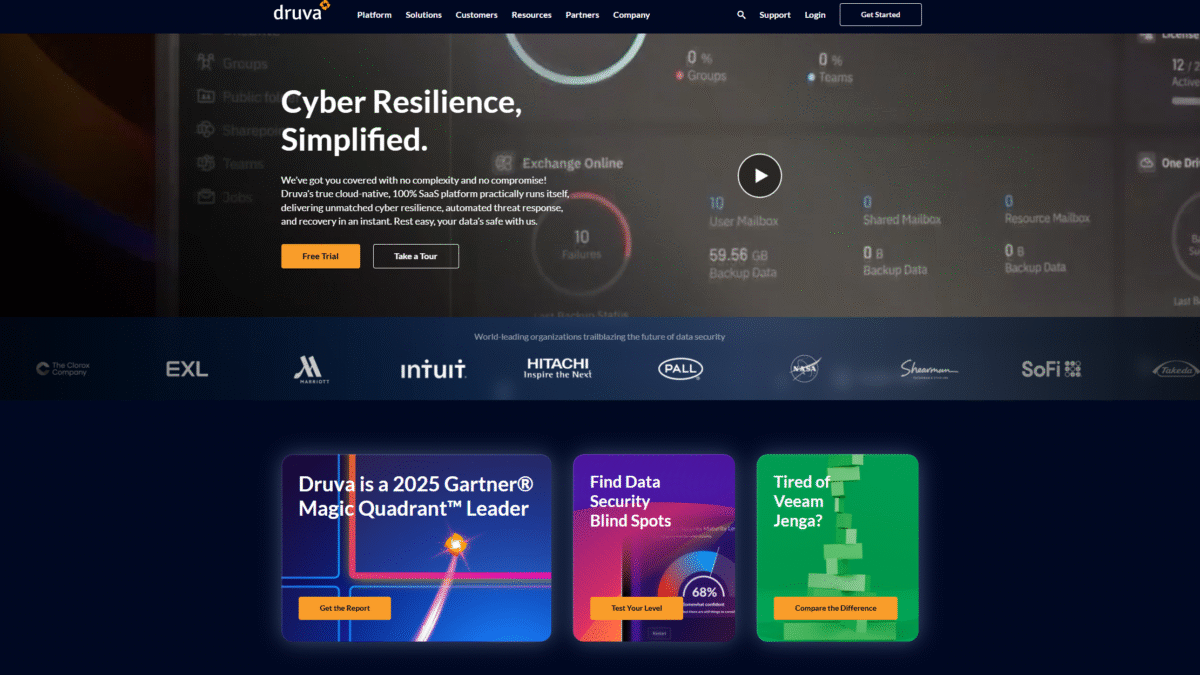
Design a Disaster Recovery Plan That Beats Ransomware
In today’s threat landscape, a disaster recovery plan is no longer optional—it’s essential. When ransomware strikes, the clock starts ticking. You need a strategy that minimizes downtime, protects critical data, and gets you back online in record time. That’s where Druva comes in. As a leading Data Security Cloud, Druva delivers fully managed, cloud-native protection and lightning-fast recovery.
Your organization can’t afford lengthy restore windows or complex hardware maintenance. With Druva, you eliminate infrastructure headaches, scale on demand, and recover up to 5x faster than legacy solutions. Ready to revolutionize your disaster recovery plan? Try Druva Free for 30 days Today.
Why Every Organization Needs a Robust Disaster Recovery Plan
Ransomware attacks have become more sophisticated and frequent. Without a solid disaster recovery plan, you risk extended downtime, data loss, regulatory fines, and reputational damage. A comprehensive plan ensures you can:
- Identify critical assets and data dependencies.
- Define recovery time objectives (RTOs) and recovery point objectives (RPOs).
- Establish clear roles, responsibilities, and communication channels.
- Test procedures regularly to guarantee readiness.
Key Components of a Disaster Recovery Plan
Risk Assessment and Business Impact Analysis
Start by cataloging potential threats—natural disasters, hardware failures, human errors, and, of course, ransomware. Then quantify the impact of downtime on each critical system. This analysis shapes your priorities and resource allocation.
Recovery Objectives (RTO & RPO)
Define how quickly you must restore services (RTO) and how much data loss is acceptable (RPO). These metrics drive your technology choices and backup frequency.
Strategies and Procedures
Draft step-by-step processes for:
- Activating alternate sites or cloud environments.
- Restoring data from immutable backups.
- Validating integrity before resuming operations.
Communication and Roles
Ensure everyone—from IT teams to executives—knows their responsibilities. Clear communication protocols minimize confusion during a crisis.
Ransomware and the Challenge to Traditional Recovery Methods
Legacy backup solutions often rely on on-prem hardware and tape libraries. Recovery can take weeks or months, leaving you exposed. Without air-gapped, immutable backups, attackers can encrypt or corrupt your archives, rendering them useless.
How Druva Elevates Your Disaster Recovery Plan
Druva offers a cloud-native approach that removes on-prem infrastructure, network egress costs, and maintenance burdens. Built on proven AWS and Azure services, Druva secures every workload—endpoints, SaaS apps, and data centers—under one unified platform.
With Druva’s zero-trust architecture and continuous data protection, you get:
- Instant air-gapped backups that ransomware can’t reach.
- AI-driven risk assessments to identify security blind spots.
- Granular recovery options for files, applications, or entire systems.
- Single-pane management across clouds and geographies.
These capabilities translate to real-world savings—up to 40% lower TCO—and up to 5x faster recovery. No hardware. No drama.
Core Features That Power Ransomware-Resilient Recovery
- Immutable Backups: Ensure stored data cannot be modified or deleted by malicious actors.
- Air-Gapped Storage: Keep critical snapshots isolated off-net for maximum security.
- Continuous Data Protection: Capture changes in near-real time to meet strict RPOs.
- AI-Based Risk Scoring: Prioritize vulnerable assets and tighten security where it counts.
- Automated Orchestration: Execute pre-defined DR runbooks with a single click for rapid failover.
Steps to Implement Druva in Your Disaster Recovery Plan
- Sign up and onboard your first workloads in minutes—no hardware setups required.
- Configure backup policies aligned with your RTOs and RPOs.
- Enable end-to-end encryption and air-gap isolation.
- Run periodic recovery drills using Druva’s automated orchestration.
- Review AI-driven resilience reports and refine your plan continuously.
Real-World Benefits and ROI
Organizations using Druva report:
- Recovery in minutes: Shrink restore times from weeks to hours.
- Cost savings: Reduce capital expenditures on backup hardware.
- Simplified compliance: Automate retention policies and eDiscovery.
- Scalable protection: Seamlessly cover remote offices and mergers.
Conclusion
Designing a resilient disaster recovery plan is critical in the age of ransomware. With Druva’s fully managed, cloud-native platform, you secure your data, cut costs, and recover at unprecedented speed. Ready to transform your approach? Try Druva Free for 30 days Today and fortify your DR strategy against any threat.
